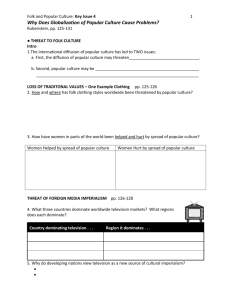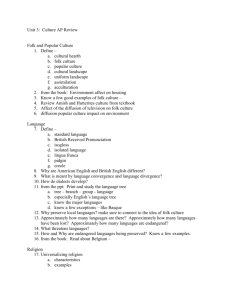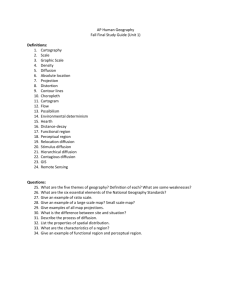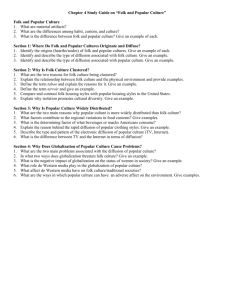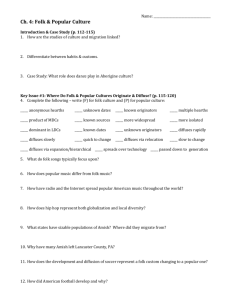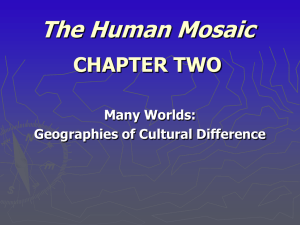Chapter 4
advertisement
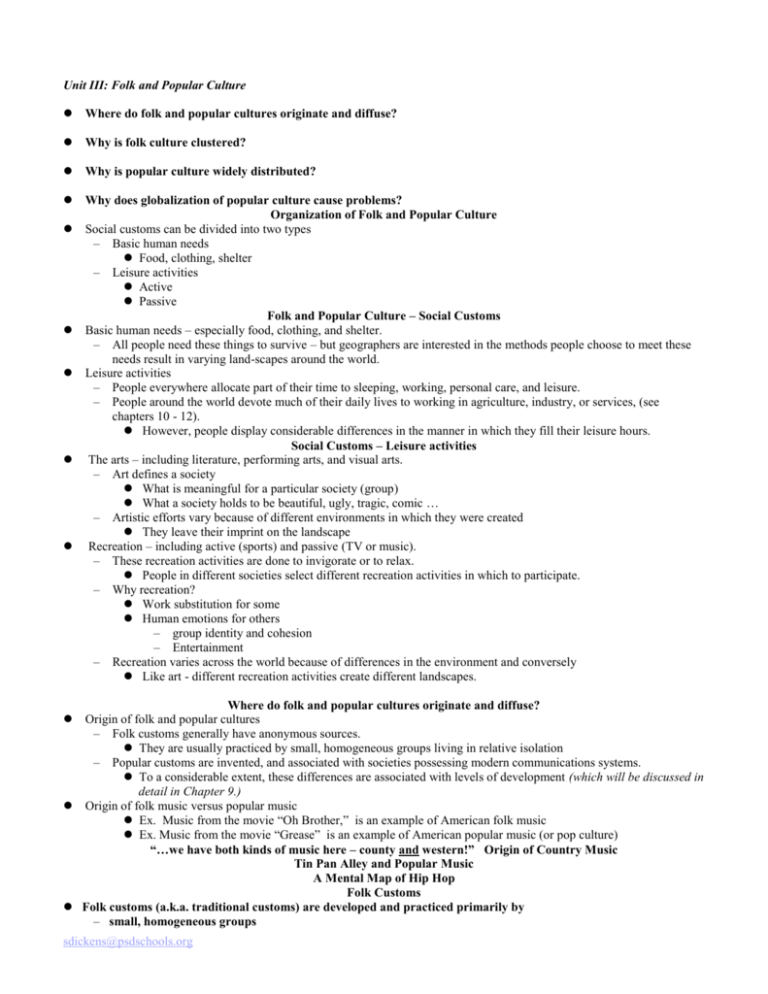
Unit III: Folk and Popular Culture Where do folk and popular cultures originate and diffuse? Why is folk culture clustered? Why is popular culture widely distributed? Why does globalization of popular culture cause problems? Organization of Folk and Popular Culture Social customs can be divided into two types – Basic human needs Food, clothing, shelter – Leisure activities Active Passive Folk and Popular Culture – Social Customs Basic human needs – especially food, clothing, and shelter. – All people need these things to survive – but geographers are interested in the methods people choose to meet these needs result in varying land-scapes around the world. Leisure activities – People everywhere allocate part of their time to sleeping, working, personal care, and leisure. – People around the world devote much of their daily lives to working in agriculture, industry, or services, (see chapters 10 - 12). However, people display considerable differences in the manner in which they fill their leisure hours. Social Customs – Leisure activities The arts – including literature, performing arts, and visual arts. – Art defines a society What is meaningful for a particular society (group) What a society holds to be beautiful, ugly, tragic, comic … – Artistic efforts vary because of different environments in which they were created They leave their imprint on the landscape Recreation – including active (sports) and passive (TV or music). – These recreation activities are done to invigorate or to relax. People in different societies select different recreation activities in which to participate. – Why recreation? Work substitution for some Human emotions for others – group identity and cohesion – Entertainment – Recreation varies across the world because of differences in the environment and conversely Like art - different recreation activities create different landscapes. Where do folk and popular cultures originate and diffuse? Origin of folk and popular cultures – Folk customs generally have anonymous sources. They are usually practiced by small, homogeneous groups living in relative isolation – Popular customs are invented, and associated with societies possessing modern communications systems. To a considerable extent, these differences are associated with levels of development (which will be discussed in detail in Chapter 9.) Origin of folk music versus popular music Ex. Music from the movie “Oh Brother,” is an example of American folk music Ex. Music from the movie “Grease” is an example of American popular music (or pop culture) “…we have both kinds of music here – county and western!” Origin of Country Music Tin Pan Alley and Popular Music A Mental Map of Hip Hop Folk Customs Folk customs (a.k.a. traditional customs) are developed and practiced primarily by – small, homogeneous groups sdickens@psdschools.org – living in more isolated rural areas. Social customs such as the provision of clothing, shelter, transportation and food have evolved differently in different areas of the world because natural resources vary widely from place to place. Folk customs reflect the benefits and constraints of each group's environment, and through cultural evolution each generation has left its unique imprint on the cultural landscape. http://www.geog.okstate.edu/users/lightfoot/folk/rolstart/main1.htm Folk or Ethnic Culture Represents greater individuality Small group distinctiveness and community oriented Stable tradition Physical representation of folk/ethnic cultures Folk and ethnic cultures are often represented through their mentifacts. – Traditional and folk art – Dances, plays, stories – Music – Housing/architecture types – Fencing and agricultural patterns When people migrate they take their building know-how and building know-what with them. – People who came from England build English-style houses in the American colonies – The French build Norman style houses Folk architecture has always utilized materials found in abundance in the local environment. These reconstructed 11th century sod buildings are built from blocks of earth cut from the tundra. – Few trees or stones are available for building materials in this part of the world: Northern Newfoundland, Canada Beehive-style houses constructed of dried earth; a material found in abundance on the arid plains of central Syria. Cone-roofed houses constructed of stone; in the very stony landscape around Fedra, near Daret Ezza, northwest Syria. Elaborate ornamentation in the stonework of a house in Thilla, Yemen . In areas where nomadism (moving to follow herd animals) is a way of life, stones or mud brick are not practical because they are too heavy to move. – These people, who frequently move their home sites, use animal skins or heavy cloth tents which can be folded or rolled up and carried to a new location (Syria). Houses constructed of palm wood and thatch, the most abundant construction material available around La Isabella settlement, Dominican Republic. Traditional "cake icing" style of architecture and decoration on Yemeni buildings in The Sana'a region. This folk architecture, complete with unique, semi-circular stained glass insets above each window in the house, is still retained in modern buildings. Traditional European architecture in the Old Town of Warsaw, Poland. Traditional architecture constructed with more modern building materials of concrete and cinder block. This neighborhood in central Amman, Jordan is typical of modern, middle class, Middle East architecture. A home-built canoe in Lake Atitlàn, western Guatemala. Traditional forms of transportation persist throughout the world, especially in less developed countries, despite the presence of, and growing dependence on, modern transport. People-powered fishing vessels in the Li River, near Yangshuo, China. Diffusion of folk and popular cultures The Amish: Relocation diffusion of folk culture sdickens@psdschools.org Sports: Hierarchical diffusion of popular culture The Amish – a true folk culture in America? Motivated by religious conviction that the “good life” must be reduced to its simplest forms, Amish communities shun all modern luxuries of the majority secular society around them – Children use horse and buggy – not school busses or cars – on their daily trip to school. Amish Settlements in the U.S. The first settlers in the New World carried with them fully developed cultural identities – Even their earliest settlements reflected established ideas of house and village form – Later they were to create a variety of distinctive cultural landscapes reminiscent of their homeland areas, though modified by American environmental conditions and material resources Vanished American Roots Native American architecture – Housing of the varied Native American groups greatly reflect environment and resources available Bark houses – Penobscots Long houses – Iriquois Tipi – Crow Mounds – Mandans Pueblo – Zuni Hogans – Navajo Plank dwellings – Puget Sound groups Native American foods and some words were passed into the American culture – but nothing from the architecture – the only example is the building styles found in the desert southwest – albeit more Spanish than Native American North American Architecture Migrant groups in North America can be identified through the architectural styles of the regions they inhabited. – The chief influences in North America came from three primary European migration streams French English Spanish Post and Beam Construction 1690-1720 Adaptations of modest English – Transition from Medieval to Renaissance Post and beam construction – Timber frame of vertical posts every 6ft. – Horizontal beams mortised to the ends to form rectangular areas (rooms) Timber and later granite foundation framing Steeply pitched roof – Originally thatched and later shingled (less pitch when shingled) The walls were shingled and the interior walls could have been filled with a plaster substance and whitewashed. The floors were dirt and later wood. Windows were small – Preserve heat & imported glass expensive Chimney was central or offset Clustering of Folk Cultures Isolation promotes cultural diversity – Himalayan art sdickens@psdschools.org Influence of the physical environment – Distinctive food preferences – Folk housing – U.S. folk house forms Himalayan Folk Cultural Regions Hog Production and Food Cultures Home Locations in Southeast Asia House Types in Western China Homes all over China in pre-modern times had a lot in common. The way of laying out a house was similar among the rich and poor, both in earlier and later times. Certain materials and techniques, such as pounded earth foundations, timber framing, and use of bricks and tile were present throughout the country. French influence in the Lower St. Lawrence Valley In French Canada, beginning in the mid-17th century, three major housing types were introduced: – Norman cottages – The Quebec Cottage – The Montreal House Urban Also introduced by the French migrants was – The Quebec long barn These can be found only in Canada – not Louisiana, Missouri or Maine – where other French-influenced architecture can be found The Norman Cottage The Quebec Cottage The Montreal House The Quebec Long Barn Diffusion of House Types in U.S. Dates and styles of diffusion of New England house types during the 18 th and 19th century Remember à as settlers migrated they carried memories of familiar house types with them and built similar structure on the frontier – Based on the date of migration the housing type is somewhat predictable House of the Seven Gables 1668 Captain John Turner, merchant mariner built this dark rambling multigabled house, considered quite luxurious for its time, on Salem Harbor in 1668. – It has been immortalized by Nathanial Hawthorne in his famous novel. It is a prime example of early colonial architecture with its medieval influence. – Originally a 2 room structure, post and beam construction, hand hewn timbers, steep roof with gables, small window openings, built to last. – A secret staircase to an old garret adds to the mystery of this old home in a town famous for its witch trails. Longfellow’s House 1759 Georgian style refers to a style originating in England in the 1600's based on forms following the classical principals of design developed by Andrea Palladio during the Italian Renaissance. By 1700 Georgian designs reached the American colonies in the form of architectural manuals and pattern books. – Building boom in 1700s – Wealthy captains, merchants, shipyard owners, and mill owners Style adapted to – Immediate surroundings – Climate – Puritan influence The windows almost touched the cornice or roof. sdickens@psdschools.org – – Very little overhang of roof. Double hung windows with 12 over 12 panes or 9 over 9. Paul Revere’s House 1680 Located in Boston, MA Type? – Revere’s father was a French immigrant named Appolos Rivoire who came to Boston in 1723 – The house was built about 1680 Former parsonage of Second Church of Boston Occupied by Increase Mather and Cotton Mather – During the mid-eighteenth century the front roof line was raised and a partial third story added Type? ITALIANATE 1840-1885 Decorative brackets under eaves, often paired; low-pitched, hipped roof; window hoods; tall, narrow windows, commonly arched. ENGLISH TUDOR 1900-1935 Combinations of: half-timbering, casement windows, steep gables, prominent chimney, chimney pots, Tudor arch, brick, stone, wood or stucco. ENGLISH COTTAGE 1915-1940 Smaller in scale and featuring simpler combination of Tudor details. GEORGIAN REVIVAL 1910-1935 Formal, symmetrical facade; central, pedimented entry; detailed cornice; classical details, especially around door; commonly red brick. ITALIAN RENAISSANCE REVIVAL 1890-1930 Series of arches, grouped or singular; green or red tile roof; decorative crests on facade; Palladian windows or openings; often light-colored brick. SPANISH COLONIAL REVIVAL 1915-1940 Red tile roof; stucco walls; arched openings; often has rustic wood doors and wrought-iron window grilles. FRENCH ECLECTIC 1915-1945 Resembles Tudor style except tall, steeply pitched roof has flared eaves and house commonly has prominent, round tower PRAIRIE 1900-1920 Low, spread-out appearance with wide overhanging eaves; wide, horizontal bands of windows; first popularized by Frank Lloyd Wright. HOMESTEAD 1900-1920 1 1/2- or 2 1/2-story, simple rectangular box with front- gabled roof and columned front porch; sometimes called "Temple-Front" house. AMERICAN FOUR-SQUARE 1905-1925 Same as 2 1/2-story Homestead house except has hipped roof instead of gabled; dormer window in roof. CRAFTSMAN 1910-1930 Simple brackets or exposed rafter ends under eaves; squared porch supports made of wood, stone or brick; broad front porch; broad gable(s). QUEEN ANNE VICTORIAN 1880-1910 Steep, irregular-shaped roof; highly decorative mixture of shapes and wall textures, including shingles; asymmetrical facade. DUTCH COLONIAL REVIVAL 1895-1930 Primary identifying feature: gambrel roof. Symmetrical - balanced, identical on left and right sides Asymmetrical - not balanced Half-timbering - exterior wood framing with spaces filled with stucco Charleston Single House Shotgun (shogun –Nigerian) House Four over four house Dogtrot house History of Barns in the US From the days when Thomas Jefferson envisioned the new republic as a nation dependent on citizen farmers for its stability and its freedom, the family farm has been a vital image in the American consciousness. As the main structures of farms, barns evoke a sense of tradition and security, of closeness to the land and community with the people who built them. Such buildings embody ethnic traditions and local customs; they reflect changing farming practices and advances sdickens@psdschools.org in building technology. http://www.gono.com/village/bwemporium/history/barn%20emp%20history.htm Pennsylvania Dutch Barn Post and Rail Buck and Rail Fence Woven Fence Angle Rail, Snake, or Worm Fence U.S. House Types, 1945–1990 Wide Dispersion of Popular Culture Diffusion of popular housing, clothing, and food – Popular housing styles – Rapid diffusion of clothing styles – Popular food customs Television and diffusion of popular culture – Diffusion of television – Diffusion of the internet – Government control of television Alcohol Preferences in the U.S. Per capita consumption of rum (top) and Canadian whiskey (bottom) show different distributions and histories of diffusion. U.S. House Types by Region Small towns in different regions of the eastern U.S. have different combinations of five main house types. Impacts of the Globalization of Popular Culture Threats to folk culture – Loss of traditional values – Foreign media dominance Environmental impacts of popular culture – Modifying nature – Uniform landscapes – Negative environmental impact Wine Production per Year The distribution of wine production shows the joint impact of the physical environment and social customs. Diffusion of TV, 1954–1999 Television has diffused widely since the 1950s, but some areas still have low numbers of TVs per population. Distribution of Internet Hosts The U.S. had two-thirds of the world’s internet hosts in 2002. Diffusion of internet service is likely to follow the pattern of TV diffusion, but the rate of this diffusion may differ. Golf Courses in Metropolitan Areas The 50 best-served and worst-served metropolitan areas in terms of golf holes per capita, and areas that are above and below average. “Pop” Culture General mass of people Primarily urban based Constantly adopting, conforming to and quickly abandoning ever-changing common modes of behavior and fads of material and non-material culture “Pop” Art Campbell’s Soup Can (1962) by American pop artist Andy Warhol – One of a number of virtually identical paintings done by the artist in the early 1960s. – The cartoon-like image, flat and simplified, is characteristic of pop art. – Warhol selected his subject matter from amongst images already present in popular culture or advertising, sdickens@psdschools.org thereby keeping his work intentionally impersonal. Roy Lichtenstein (1923 - 1997) American painter, draughtsman and illustrator – The master of the stereotype – Most sophisticated of the major Pop artists in terms of his analysis of visual convention and his ironic exploitation of past styles. – He made use of devices which were to become signatures in his work So-called Ben-Day dots Lettering and speech balloons. “Pop” Music One of the most famous ensembles of the rock-and-roll era, the Beatles greatly influenced the culture and music of the 1960s and beyond. – Formed in 1960 in Liverpool, England, the Beatles stayed together for ten years, creating a sophisticated and varied sound that fans continue to enjoy and bands continue to emulate. – The Beatles stood at the forefront of the musical phenomenon known as the “British invasion,” a name referring to the tremendous effect that British rock-and-roll bands had in the United States during the 1960s. “Pop” Music Dickens Opinion Occasionally an item, idea, or article of popular culture may have the ability to outlast the fleeting nature of human interest and will become a permanent part of culture. sdickens@psdschools.org
